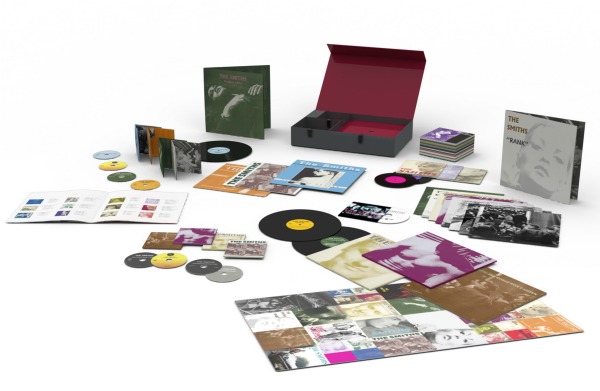
One of the best and most underrated Smiths songs ever is “Paint a Vulgar Picture,” a screed against the exploitative practices of record labels from Strangeways, Here We Come. When Morrissey wrote that song in 1987, the music industry was in somewhat better shape than it is today. Napster was more than a decade away, and the recently introduced CD format was making music more durable, portable, and profitable than ever before. Not only were new albums marketed on the new format, but the clear practical advantages it provided over vinyl LPs offered a convincing case to consumers that they should invest their hard-earned dollars in repurchasing music they already owned. “Digitally Remastered From the Original Master Tapes” and “A Two-Record Set on One Compact Disc” quickly entered into the music fan’s everyday vernacular, and nearly 25 years later, they’ve never left. This month, Rhino will release an eight-disc box set containing newly remastered versions of the Smiths’ entire catalogue.
Major labels have increasingly struggled to sell new music in recent years, but one thing they’ve never stopped doing is trying to convince people to shell out money for their favorite albums for a second, third, fourth, or fifth time. Nirvana’s Nevermind, already owned by everyone remotely interested in rock music, was released last month as a “Super Deluxe” four-disc set loaded with demos, alternate takes, and live recordings. A new box set of Pink Floyd’s discography was released recently, as well as various iterations of a Dark Side of the Moon reissue that ranged from two to six discs (similar treatments for Wish You Were Here and The Wall are in the works for later 2011 and early 2012). A so-called “director’s cut” of The Who’s Quadrophenia will be released later this month. U2 has planned a massive reissue campaign around the twentieth anniversary of Achtung Baby, with one package costing roughly as much as an iPad. These are all records you probably own if you’re reading this. But you don’t have them remastered with the very latest technology. You don’t have every alternate take of “Lithium.” Unless you’re a bootleg collector, you probably don’t have the 1974 live performance of Dark Side that’s included in that album’s deluxe package. You don’t have all this stuff, and you need it, lest you risk not being a real fan. That’s what the record companies want you to think as they stick triple-digit price tags on these albums.
It’s nakedly obvious why they’re doing this. The major labels have lost the war against piracy. They declare victory when Taylor Swift or Lady Gaga sells as much in a year as N’ Sync and Eminem sold in a week 10 years ago. The entire system is on life support, and they know this all too well. The one thing they still have is their five-plus decades of material, which they are understandably milking for everything they can get in order to compensate for their inability to sell new music. It flies in the face of everything “rock and roll,” and everyone knows this. But no matter how hard I try, I can’t hold it against them.
As excessive as the constant reissuing of well-worn albums is, as blatantly money-focused these efforts are, I love this stuff. The live Dark Side performance should be required listening for any Pink Floyd fan. Some of U2’s best work could be found as B-sides for Achtung‘s singles. Having all of them on one disc packaged with a remastered version of the album isn’t the worst thing in the world (although for the price of the “Über Deluxe” edition, the “Fly” sunglasses had better be tour-worn). The Smiths’ catalogue, much like that of the Beatles prior to their terrific remastering campaign in 2009, hadn’t really been updated since the original CDs were released in the 1980s. Letting Johnny Marr give Meat is Murder and The Queen is Dead sonic overhauls 25 years after their release feels necessary, just like Francis Ford Coppola’s 2008 Blu-Ray restoration of the Godfather movies was necessary. I like learning new things about my favorite albums. Being able to trace a song’s genesis through demos is fascinating. Want to throw in some extra artwork or liner notes? So much the better. One of the biggest complaints vinyl purists have about the CD format is that some of an album’s aesthetic beauty is lost in translation. I haven’t gotten my hands on the Quadrophenia box set yet, but I’m not worried about being shortchanged visually.
This is why labels will probably never stop repackaging their best-known work, even after every other use for the CD format is gone. The most revered albums will never stop having a fan base, and this fan base will never stop wanting the biggest, most expanded, most modern-sounding versions of the albums they know and love. And I’m fine with that.

